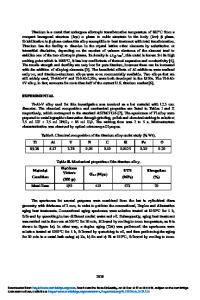Influence of Dynamic Nonequilibrium Processes on the Mechanical Properties and Corrosion Resistance of Titanium Alloy
- PDF / 814,515 Bytes
- 8 Pages / 594 x 792 pts Page_size
- 93 Downloads / 436 Views
INFLUENCE OF DYNAMIC NONEQUILIBRIUM PROCESSES ON THE MECHANICAL PROPERTIES AND CORROSION RESISTANCE OF TITANIUM ALLOY М. H. Chausov,1 P. О. Marushchak,2, 3 A. P. Pylypenko,1 and Ya. M. Khaburs’kyi4 We compare the mechanical properties and corrosion resistance of specimens made of sheet two-phase VT22 high-strength titanium alloy in the intact state, after static tension, and after realization of dynamic nonequilibrium processes with subsequent static tension. It is shown that one-time dynamic nonequilibrium processes realized under impact vibration loading significantly increase the initial plastic deformation in this alloy and almost do not affect its corrosion resistance. Keywords: impact vibration loading, dynamic nonequilibrium process, high-strength titanium alloy, mechanical properties, corrosion resistance.
It is known that impact loads may lead to a coherent behavior of some elements of the analyzed system (self-organization) accompanied by significant changes in the mechanical properties of the material. The application of the indicated methods of treatment (e.g., laser impact wave loading) made it possible to create materials with improved physicomechanical properties [1, 2]. This approach is also actual for the mechanics of materials. However, up to now, there are no substantiated procedures of mechanical testing of structural materials in the course of dynamic nonequilibrium processes (DNP), which would guarantee the repeatability and reliability of reproduction of the results. This means that the mechanical behavior of materials in the DNP is insufficiently well studied [3].
An efficient procedure of reproduction of the DNP by the high-speed tension of materials with superposition of high-frequency vibration processes (several kHz) was developed for the first time in [4, 5]. This loading mode was realized by the modification of a testing machine containing two contours: external (including the loading frame of the testing machine) and internal. The internal contour represented the simplest statically indefinite structure of three parallel elements, which simultaneously loaded the central specimen and two symmetric specimens-satellites (brittle samples) with different cross sections made of 65G or U8-U12 hardened steels. In the process of loading of this structure, the specimens-satellites were destroyed under preliminarily specified loads or strains. As a result, we realized a given impulsive introduction of energy into the external contour of the testing machine and into the material of the investigated specimen with realization of the indicated impact vibration loading. The frequency of these vibrations was equal to the natural frequency of vibrations of the testing machine. The analysis of the results obtained for materials of different classes shows that, in the transient loading modes with short pulses of force loading, when the dissipation of energy in the classical sense (i.e., the transformations of the mechanical energy into heat) did not originate yet, one may observe the self1 2 3 4
Nationa
Data Loading...











